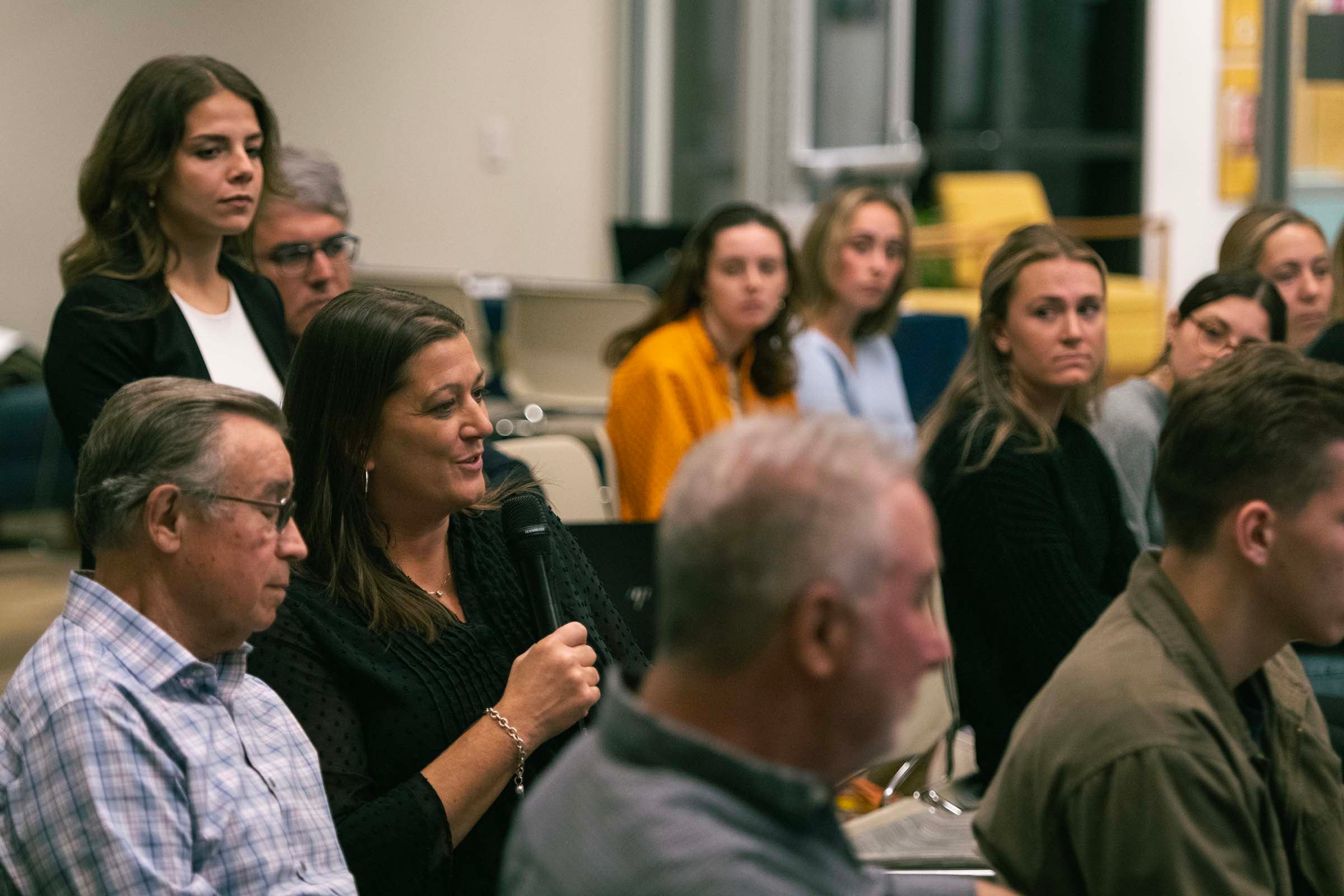URI art professor’s work featured in ‘Minecraft’video game
KINGSTON, R.I. – Nov. 3, 2025 – While at a curator’s house in Europe on an international art exhibition trip more than a decade ago, Travess Smalley first saw the digital world of Minecraft watching a young child play the game by bringing to life pixilated digital worlds from the ground up.

After watching—and subsequently playing—Minecraft, Smalley, an assistant print media professor at the University of Rhode Island, immediately drew parallels between utilizing Legos to build different creations and viewing his art in ways that can lead to complex and unpredictable results.

“When you’re working with blocks, or kits of parts, you have these units that can be combined in many ways to make new things. We all have the same paint palette, but we make different paintings,” Smalley said. “From that moment, I locked into this idea of generative play and the kind of emergent things that come out of games that you can’t predict, and how there is a symmetry between gameplay and the studio practice. Since then, it has informed the way I think about artmaking.”
Little did Smalley realize that the best-selling video game of all time would become his canvas. Woven into the blocky dirt and pixilated grass within Minecraft are some of Smalley’s unique artworks formulating the various fantasy worlds within the 3D gaming experience.
Having his work included in a game that has sold more than 350 million copies worldwide reaffirms Smalley’s research into creativity and gameplay, he says. That review, Smalley says, broadly looks at how people are creative when they play games even when they’re not thinking about it.
“Whether it’s people figuring out how to bring in agentic artificial intelligence [autonomous AI systems that can act independently to achieve specific goals without human intervention] into video games or people who take games and make oil paintings, we look at all the ways that this happens,” Smalley said. “In other words, you can make art and be creative inside of games, and you can also use games as tools to make artworks that exist outside of it.”
Smalley creates his art pieces, including those in Minecraft, through a “chance flower” program. It randomly generates different landscapes through Photoshop based off code he’s written.
“The idea of this is that every piece is unique,” Smalley said. “When you’re playing Minecraft, every world is procedurally generated and unique. If you open it and press ‘play’ on a new world, it’s going to be a different world if you open it on a new computer and press ‘play’ again. When I’m making a script, I’m saying I want a sun and want this here. But I’m also leaving a lot of room for chance.”
Smalley’s art practice and interest in Minecraft reached new levels during the COVID-19 pandemic. Smalley was one of four artists to obtain a residency at the MacKenzie Art Gallery in Canada and receive funding to create work on a Minecraft server stored at the museum.
Smalley said his residency proposal was based around “concrete poetry” in ways of modding Minecraft from being a game into a “reading experience.” Through that, Smalley created a digital world in Minecraft where the scene’s original grass, stone and dirt was replaced with text on a white surface.
“The whole idea was turning Minecraft into a large poem,” Smalley said. “I’m quite proud of how the scene turned out.”
Over the last five years, Smalley’s Minecraft work has also inspired him to create “pixel rugs,” generative digital art works that have been turned into hand-woven wool rugs. Similar designs are also featured in the Minecraft game. Smalley and his work were spotlighted by Minecraft in its annual “Minecraft Live” event, showcasing artists involved in and inspired by the game, including in a documentary streamed on YouTube.
Last summer, Smalley created and released a video maze game called “CRAWL,” a series of 512 different artworks forming labyrinthine maps and passages, through the online software gallery Feral File. Smalley says CRAWL functions both as map exploration through procedurally generated worlds for gamers and “as a painting.”
Beyond the gaming world, Smalley also expects to release a book featuring the digital versions of his pixel rugs, aptly titled “Pixel Rugs,” in January 2026. One of Smalley’s signature rugs was also recently featured in Architectural Digest.
Smalley’s students are also involved in Minecraft-related artwork in the classroom—including a project in which students turn the game into a drawing tool, enabling their character to make lines wherever they move it around the digitized world.
Smalley challenges his students to view their creative outlook as a “muscle” they train, similar to a gym workout, and to find additional avenues to display their art. He hopes the Minecraft work acts as a springboard to build additional student interest in his classes.
“The goal is for students to feel fearless with new technologies as platforms for making art,” Smalley said, “They shouldn’t feel limited by thinking they need a certain set of brushes or oil paint. Art can be made anywhere.”
Latest All News
- Sharing good deeds online boosts trust and connection, URI study findsKINGSTON, R.I. – Nov. 3, 2025 – Social media has become such a force that it has become rare to speak with someone without a Facebook, X or even a LinkedIn presence. Scrolling through a timeline on any social media platform will bring up a slew of content. Often leading individuals to form opinions about […]
- Energy topics and voices at URI’s 2025 ‘Plugged Into Energy’ lecture seriesKINGSTON, R.I. – Nov. 3, 2025 – The University of Rhode Island Cooperative Extension Energy Literacy Initiative is hosting its annual Plugged Into Energy Research lecture series this fall. The goal is to increase literacy around energy topics of concern in Rhode Island. All are welcome. This year’s series includes three lectures, with one in […]
- Chatbot helps older adults manage multiple chronic conditionsKINGSTON, R.I. — Nov. 3, 2025 — By the year 2030, more than one-quarter of Americans will be 65 or older, 80% of whom will be living with one or more chronic disease. At the same time, many older adults find themselves living alone, which creates unique physical, psychological, and social challenges that are often […]
- This Week In Sports – 10/30Football FINAL (10/25): University of Rhode Island 38-17 Bryant University Football celebrated family weekend by taking down in-state rival Bryant on Saturday. The Bulldogs struck first with an early passing touchdown, but second-year running back Gabe Winowich responded with a 51-yard rushing touchdown five minutes later. His five-yard rushing touchdown just 44 seconds later to... The post This Week In Sports – 10/30 first appeared on The Good 5¢ Cigar.
- CAA Power Rankings – Week 9We’re down to the final four weeks of the Coastal Athletic Association regular season, and all spots outside of the top three are still up for grabs. Each week, The Good Five Cent Cigar Sports Staff comes up with its cumulative ranking of CAA football teams. Here is what we came up with following week... The post CAA Power Rankings – Week 9 first appeared on The Good 5¢ Cigar.
- WBB Season Preview 2025-26: ‘Expectations have never been higher’The following article is an opinionated preview of the upcoming women’s basketball season. Coming off its fifth straight season with an over .500 record, the University of Rhode Island women’s basketball team heads into the 2025 campaign with high expectations and a championship mindset. After finishing 17-16 overall and 11-7 in league play, the Rams... The post WBB Season Preview 2025-26: ‘Expectations have never been higher’ first appeared on The Good 5¢ Cigar.










